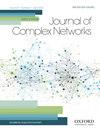目标社区合并提供了协作集群和部门分区之间的有效比较
IF 1.5
4区 数学
Q2 MATHEMATICS, INTERDISCIPLINARY APPLICATIONS
引用次数: 0
摘要
社区检测理论对于多种类型的复杂网络,特别是类人协作网络的结构分析至关重要。在这项工作中,我们提出了一种新的社区检测算法,即目标社区合并算法,该算法基于著名的Girvan-Newman算法,可以获得模块化值高且社区数量少的社区分区。然后,我们对萨拉戈萨大学科学合作网络的部门和社区结构进行了分析和比较。因此,我们从部门间和部门内部的合作结构中得出有价值的结论,这些结论可能对最终的部门重组决策有用。本文章由计算机程序翻译,如有差异,请以英文原文为准。
Targeted Community Merging provides an efficient comparison between collaboration clusters and departmental partitions
Community detection theory is vital for the structural analysis of many types of complex networks, especially for human-like collaboration networks. In this work, we present a new community detection algorithm, the Targeted Community Merging algorithm, based on the well-known Girvan–Newman algorithm, which allows obtaining community partitions with high values of modularity and a small number of communities. We then perform an analysis and comparison between the departmental and community structure of scientific collaboration networks within the University of Zaragoza. Thus, we draw valuable conclusions from the inter- and intra-departmental collaboration structure that could be useful to take decisions on an eventual departmental restructuring.
求助全文
通过发布文献求助,成功后即可免费获取论文全文。
去求助
来源期刊

Journal of complex networks
MATHEMATICS, INTERDISCIPLINARY APPLICATIONS-
CiteScore
4.20
自引率
9.50%
发文量
40
期刊介绍:
Journal of Complex Networks publishes original articles and reviews with a significant contribution to the analysis and understanding of complex networks and its applications in diverse fields. Complex networks are loosely defined as networks with nontrivial topology and dynamics, which appear as the skeletons of complex systems in the real-world. The journal covers everything from the basic mathematical, physical and computational principles needed for studying complex networks to their applications leading to predictive models in molecular, biological, ecological, informational, engineering, social, technological and other systems. It includes, but is not limited to, the following topics: - Mathematical and numerical analysis of networks - Network theory and computer sciences - Structural analysis of networks - Dynamics on networks - Physical models on networks - Networks and epidemiology - Social, socio-economic and political networks - Ecological networks - Technological and infrastructural networks - Brain and tissue networks - Biological and molecular networks - Spatial networks - Techno-social networks i.e. online social networks, social networking sites, social media - Other applications of networks - Evolving networks - Multilayer networks - Game theory on networks - Biomedicine related networks - Animal social networks - Climate networks - Cognitive, language and informational network
 求助内容:
求助内容: 应助结果提醒方式:
应助结果提醒方式:


